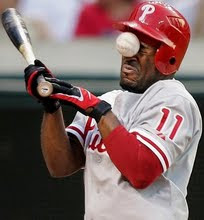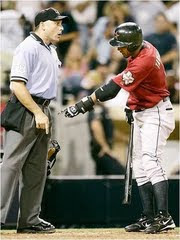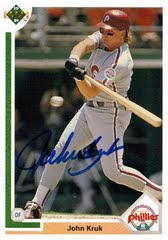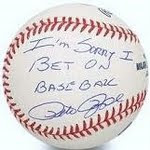Despite the abysmal 4.69 K/9 rate and 4.77 FIP (3.96 ERA), there was much to love about Rick Porcello's campaign last year: quality control over his four-pitch mix (2.74 BB/9, 3.6 MLB average), top-tier worm burning tendencies (1.89 FB/GB, 7th best amongst MLB starters who logged 150+ IP, and a 54.2% GB rate) and the potential for improvement which is inherent in youth (he cannot legally drink until the end of December) and an unlucky HR/FB rate (14.1%, MLB average is 11% >> Porcello's xFIP was a lower 4.52). The strikeout rate is not as scary as it seems if you look at Porcello's monthly pitching splits. Take notice that his K/9, though still below the MLB average each month, was heavily depressed by a poor strikeout showing in June and September (in June/Sept, Porcello's K/9 was below 4.0, while his K/9 was no lower than 5.0 in any other month). You might go so far as to call Rick Porcello a young and better Mark Buehrle.
In real life, Fangraphs qualified Rick Porcello's 3.96 ERA, 1.34 WHIP, 14 W and 89 K performance as being worth 1.9 WAR or $8.9 million in 2009. Yahoo, meanwhile, ranked Porcello as the 263rd most valuable player in fantasy baseball. This represents a sizable profit for Porcello buyers given his 396 pre-season ranking, but nonetheless hinging on the margins of fantasy relevance in standard leagues. The question of improvement/decline is critical in determining whether or not Porcello will provide worthwhile fantasy value in 2010.
First, we look towards injury risk. In my 2009 fantasy drafting primer for pitchers, I detailed the important and relevance of workload and age to injury risk:
Baseball Prospectus has shown, pitchers are most brittle before the age of 24 and after the age of 35. Tom Verducci observed that pitchers under the age of 25 who increase their seasonal workload by more than 25-30 innings in a single season are the most susceptible to injury the following year.Porcello, at age 20, took a 45 innings pitched leap compared to his 2008 minor league campaign (170 IP in 2009, 125 IP in 2008). This represents a sizable risk, but a pair of factors tend to abate these concerns. Despite posting 170 innings in junior circuit in 2009, Rick Porcello was not among the 150 most abused arms in baseball. Clay Buchholz had a more abused arm and he only pitched in the majors for like fifteen minutes last year. Porcello's relatively low PAP rating is largely due to the fact that the Tigers did an excellent job regulating Rick Porcello's workload per game in 2009. Porcello only topped the 100-pitch mark four times in 2009 and only once did he toss over 104 pitches (111, on 9/29).
Next, we look towards Porcello's luck and progress factors and whether they point towards regression, stabilization or improvement. These factors include HR/FB rate, LOB% and age.
As mentioned above, Porcello was unlucky with the long ball in 2009. Despite pitching in a relatively neutral, though slightly hitter-friendly, ballpark and posting a top ten GB/FB rate amongst starting pitchers, Porcello posted a 14.1% HR/FB rate, which is the fourth-highest mark amongst all starting pitchers who threw 150 or more innings in 2009. This number usually stabilizes in the 10-11% range for pitchers over the course of their career and some regression towards the mean (improvement) is reasonably inferable. This is represented in the fact that Porcello's xFIP is a quarter run below his actual FIP.
There is also the matter of LOB%. There has been plenty of statistical work done to prove that once a ball is in play, the pitcher does not control the outcome of that play (outside of any defensive work he may be required to employ). Thus, LOB (Left On Base) percentages tend to normalize amongst starting pitchers, although pitchers with higher strikeout rates tend to strand more runners than average (the counter-positive is also true). In 2009, the league average LOB% was 71.9%. Rick Porcello's was 75.5%. Before we scream "regression, regression, regression" regarding LOB%, however, it is important, as implied above, that we analyze the defensive prowess of the players behind the pitcher. A pitcher who plays in a cavernous ball park and has a great defense behind him tends outperform their peripherals (see Jarrod Washburn's numbers before his trade to Detroit in 2009). The opposite is true for pitchers playing in front of poor defenses (see Javier Vazquez on the White Sox, circa 2006 and 2008). As a heavy groundball pitcher, Rick Porcello relies upon his infield defense almost 55% of the time. In 2009, the Tiger's best defensive starters (and in fact only good defensive starters) were stationed in the infield. 2B Placido Polanco (+12.1), SS Adam Everett (+8.9), 3B Brandon Inge (+8.5) and 1B Miguel Cabrera (+3.4 >> yeah I know, I'm as shocked as you are) combined to be worth approximately +3.3 WAR on defense by preventing 33 runs from scoring compared to the average major league defense. Such is strongly indicative of a maintainable LOB% above the MLB average.
Finally, looking at Porcello's age, there is plenty of room to expect some, if only modest, improvement in his skill set going forward. The 5+ K/9 in four out of five months in 2009, quality command of his pitches and extreme groundball tendencies are a recipe for success. Rick Porcello, who will be 21 in 2010, is not even entering his prime yet (usually ages 24-31). There will surely be bumps along the way as Rick Porcello grows as a pitcher, but the early signs for success are positive. Porcello does not project to be a Justin Verlander or Felix Hernandez, but a poor man's Greg Maddux is nothing unreasonable.
So what does this say for Rick Porcello's 2010 prospects? Well for one thing, if the Tigers let free agents to be Adam Everett and Placido Polanco (who collectively prevented 21 runs above average from scoring) go without replacing their up the middle prowess, one can reasonably expect a slight, if not sharp regression in Porcello's 2010 LOB% and surface numbers (such as ERA; see FB pitcher Javier Vazquez's change in ERA from 2007 to 2008 as the White Sox OF went from defensively above average to defensively poor). In 2009, the Tigers collectively paid Everett and Polanco $5.6 million, but Fangraphs, who valued a win at $4.5 million last year, valued their defensive contributions alone at $9+ million (and their collective, all-around value at $18.7 million). Even if the Tigers want to be cheap next year, the Tigers should consider resigning their middle infielders. At the right price (let's say $6 million a year for Polanco and $3 million per for Everett), both players are good defenders with, at worst, league average bats, who could easily provide the team with more than they are paying. This is, of course, a problem with the likes of Magglio and D-Train on the books. Perhaps the Tigers can find a team who is willing to take on some (if not more) of the salary and risk inherent in these two aging, sub-replacement level players for absolutely nothing in return (see the Alex Rios to Chicago deal) in order to free up the salary necessary to resign Everett and Polanco. This seems like a much wiser idea than letting the team's two best defensive players walk and replacing them with replacement level players (and allow Magglio and D-Train to provide the team with poor value). The Tigers had a $115+ million payroll in 2009 and its hard to imagine that a franchise like the Tigers have much payroll flexibility for 2010, given a projected payroll upwards of $116 million before arbitration.
Alas, much of the politics of who to/not to sign is a digression from the point. What is important is that Rick Porcello's 2010 fantasy value largely will hinge upon the free agency moves that the Tigers do/do not make this off season. If the Tigers let their middle infield combination walk and do not replace their defensive contributions, I would push Rick Porcello's borderline relevant fantasy numbers towards irrelevancy. If the Tigers bring Everett and Polanco back (or somehow manage to otherwise improve defensively (like never playing Magglio in the outfield ever again...), Porcello may be a great late round pick and trade chip.
____
Click the new "Fantasy Outlook" tag to follow the series. Last year's posts have been updated with the new label.







9 comments:
i stopped reading when you compared rich porcello to greg maddux. nothing you could say would forgive that mishap
1) I said POOR MAN's greg maddux.
2) Compare their early career numbers. I'm not talking about Ian Kennedy here.
speaking of which, why is ian kennedy so bad? he had good, translatable numbers all through the minors. Probably needs a second chance
Did u write this in Torts?
also in post in unnecessarily long and I stopped reading when you said he was beatter than mark Buehrle haha
Fuck BOTH of you!
1) Yes I wrote this in Torts
2) I love Ian Kennedy and was being ironic
3) TBO, you hate ian kennedy. Or was it Kei Igawa...
4) Read the whole post damnit!
Porcello is better than Mark Buehrle, btw.
let me know when Rick Porcello throws a perfect game, wins a world series, wins 100+ games, and also throws another no no.
Obviously a lot of things wrong with that statement but rick porcello is NOT better than Buerhle. Will he be, probably, it's not THAT hard to do, he is not better than Buehrle
This is a long post! Rick Porcello is a good young pitcher. He may develop this next year to be a good fantasy picks or he could be like Felix Hernandez and take several years to develop into a good pitcher. You just never know. Depending on where he goes he may be a good pick. He fits into my strategy.
Post a Comment